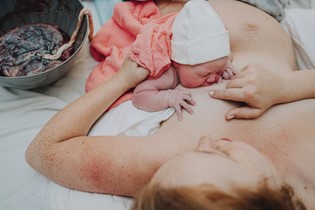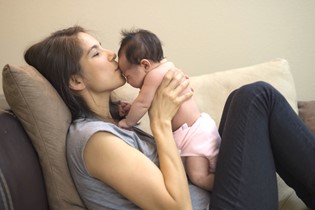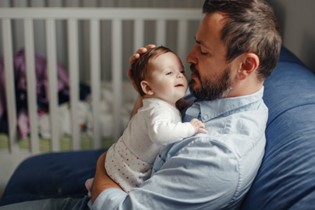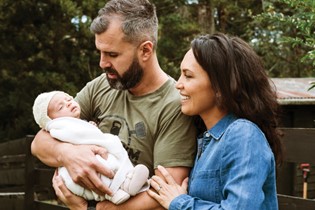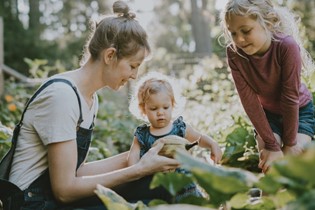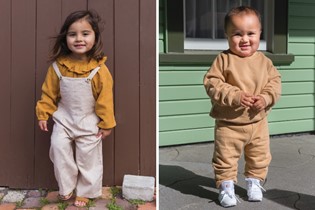Sleep basics: from 12 weeks to 12 months
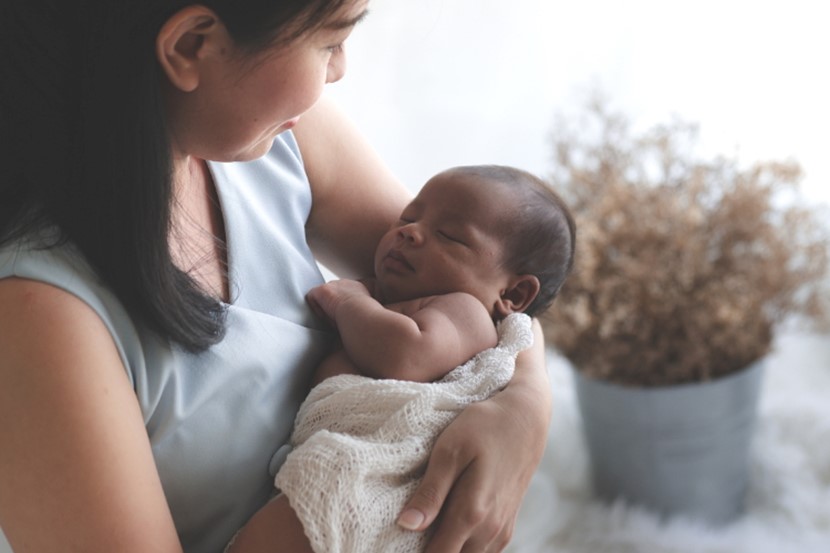
In her latest book, Simply Parenting: From 12 weeks to 12 months, Dorothy Waide answers the questions that all new parents ask: when should I start my baby on a routine? How do I encourage my baby to sleep through the night? How do I teach my baby to self-settle? Why does my baby cry all the time? In this abridged extract, we share some of Dorothy’s pearls of wisdom, gleaned from her 50-plus years of nurturing babies.
The all-important topic of sleep seems to govern many of our conversations once we have had a baby, and it can be a fairly controversial and divisive one. Sadly, we often find ourselves comparing our experiences with others, and it may seem that everyone else has the ‘perfect’ baby. Remember, other parents might be omitting to mention or glossing over any issues they have. In reality, there’s no such thing as a ‘perfect’ baby – or a ‘perfect’ parent.
Melatonin
Sometimes, unexpectedly, your baby might start catnapping during the day and waking more overnight. Up until now your little one had been sleeping perfectly through their daytime naps as well sleeping long stretches at night. Why the change? Please don’t worry, you’re not alone; this is easily explained by one word: melatonin.
Melatonin is a hormone produced in the pineal gland of the brain and which plays an important role in the regulation of sleep cycles. It’s often referred to as the ‘hormone of darkness’ rather than the hormone of sleep. When your baby was still in the womb, melatonin was happily passed through the placenta and into your baby, but now, after just a few weeks in the open air, that supply of melatonin has disappeared and suddenly you find your once-peacefully sleeping baby now waking up.
Sleep is a nutrient
It’s also important to realise that sleep performs a role other than providing a tired parent with some much-needed downtime! Like food, sleep is also a nutrient, so babies need a combination of both. It’s quite simple: if they eat well, they sleep well, and if they sleep well, then they will eat well. Sleep directly impacts babies’ mental and physical development, and once they’re on solids, I always say that their daytime nutrients are a combination of food and sleep, whereas their night-time nutrient is sleep. It’s important, then, to try to establish and establish good sleep patterns, and some flexibility may be required to achieve this. For example, babies with reflux or other medical conditions may have their sleep impacted, so they often sleep better on an adult body rather than in a cot, and it therefore takes time to get a baby with digestive issues to sleep well in their cot.
Sleep is a learned behaviour
While your baby may be born with the biological need for sleep, they do not enter the world equipped with the skill to sleep. Many parents assume that babies know when they’re tired and therefore will just go to sleep when they need to. However, falling asleep is a learned behaviour, not an innate ability. In other words, your baby does not know how to fall asleep yet and needs your guidance to teach them where to fall asleep. Be it in your arms, in a cot or bassinet or safe bed-sharing, your baby needs guidance on learning how to self-settle, resettle and sleep soundly.
Infant sleep and obesity studyA good night’s sleep has been shown to have a number of benefits for infants — including a reduced risk of developing obesity. Obesity rates have risen over the past few decades, and emerging research suggests sleep interventions in infancy may offer promise for reducing the risk of childhood obesity and the negative health associations. A University of Otago trial named the ‘Prevention of Overweight in Infancy’ study assessed whether extra education and support around sleep, breastfeeding, diet and physical activity reduced the number of children showing excessive weight gain over the first two years of life. Results showed children who received the sleep intervention had a lower Body Mass Index (BMI) than children who did not at 3.5 and five years old. |
How much sleep do babies need?
On average, most infants (aged 3–12 months) sleep for approximately 12 to 16 hours over a 24-hour period. This includes naps as well as overnight sleeping. Bear in mind that this will vary from day to day and baby to baby, because each little one is different and some simply need more sleep than others. How well your baby sleeps will influence their feeding rhythms, and so may have a positive or negative effect on you and your family. Some babies will wake around the 20-minute mark due to digestive issues, whereas others will stir or wake between 35 and 45 minutes when they ease from one sleep cycle to the next. Understanding these sleep cycles will go a long way in helping you deal with the challenges of establishing a healthy sleep pattern for your baby, so read on.
'Parenting to sleep’
There are limitless ways to be a parent, and the parenting style which suits one family will not suit another. No style is more correct than another, it’s absolutely up to you how you choose to parent and how you choose to help your baby to find sleep – or as I call it ‘parenting to sleep’. Some parents enjoy the experience of teaching their baby to fall asleep in their arms, while others prefer putting their baby in a cot. Many parents find settling baby in their arms, as opposed to a cot, easier, as it involves less bending and provides an opportunity for quiet intimacy. In some families, circumstances influence how a baby is settled; for example, if there are other siblings, a cot may be more practical.
Find what works best for you and don’t be afraid. You could mix it up from around 12 weeks onwards — perhaps practise cot- or bassinet-settling in the morning when you have more energy, and opt for settling in your arms in the afternoons. Remember, there’s no right or wrong way to parent, and ‘parenting to sleep’ is just one part of your journey.
Communication
No one likes to hear their baby cry, but remember crying is the only way for a baby to communicate with you. When our babies are using their ‘words’ we STOP, LISTEN and ACT. Ask yourself, ‘Where am I when my baby cries, and what am I doing?’ LISTEN relates to the type of cry it is. What do you think they are telling you? The ACT may mean you listen to your baby for a little longer, or intervene and give comfort while your baby is in their cot, or pick up your baby and engulf them and comfort them back to sleep. Imagine listening to your baby crying (talking) to you, and what they might be saying: ‘Mama, no sleep, me not tired’, ‘Me want a drink’, ‘Me need a cuddle’. They just haven’t yet got the language skills necessary to make their message clear.
It can be very difficult to understand the difference between acceptable crying and unacceptable crying. Honestly, how do we tell the difference? The answer is that you will not know, there’s no ‘one guideline’, no right or wrong, only your instinct — so use it!
Helping your baby find sleep
There are three main methods of helping your baby find their sleep.
No-cry solution
The ‘no-cry’ sleep solution is where you allow your baby to suck to sleep, using either the breast, a soother or a bottle, and gradually remove whatever it is you’re using. Another way of doing
a no-cry sleep solution is to introduce large movements (rocking, swinging, swaying) that will eventually put a baby to sleep. The no-cry sleep solution may work for a short time, but it can become less effective as your baby grows, from about 16 weeks onwards, because they haven’t established their own self-settling ability.
Cry it out
There has been extensive and well-publicised research into the harm done by leaving babies to cry it out. In the past few decades we have learnt more about the art of listening and the importance of being there for our babies, sometimes in the role of ‘being’ and other times in the role of ‘doing’.
The middle line of parenting
The middle line acknowledges that, yes, our babies are going to cry — they are hungry or need a cuddle, they’re too hot, too cold or in pain — this is how they communicate. This is how we get to know our little ones. By paying attention to our babies when they cry, we can work out what they’re trying to tell us, and therefore whether we need to intervene or leave them to self-settle.
This balancing act of intervene/leave comes to the fore when the baby transitions to independent sleeping. I believe the ideal and natural time for your baby to start the transition is around the 12-week stage, which coincides with the end of the ‘fourth trimester’, although some babies may be ready at around six weeks. Start with small steps, stepping back and intervening only when necessary. Remember, our role is to guide, support and teach our babies to find their sleep. Don’t forget that every so often your little one will need to be re-shown how to self-settle and resettle, so don’t be concerned if you have to start again with the settling techniques you used with your newborn. What your little one needs right now is TACT: time, acceptance (patience), consistency (aim for 80%) and touch (presence).
Adopt an ‘It is okay’ mantraIt is okay . . . ... if the house is a mess. ... to be in your PJs at 3 pm — or all day. ... to stipulate visiting times. ... to turn away visitors if you’re not up to it. ... to refuse to wake your sleeping baby just so visitors can have a peek. ... to ask house guests to wait on you, rather than the other way around. ... to request visitors wash their hands or use hand sanitiser before holding your baby. |
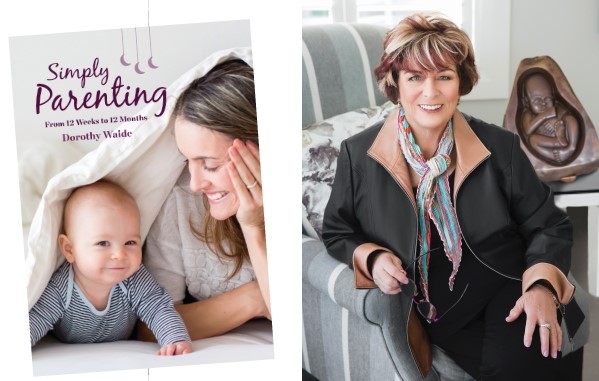
For a comprehensive guide on techniques used in teaching baby to self-settle and re-settle, grab a copy of Dorothy’s book: Simply Parenting: From 12 weeks to 12 months, RRP$40, Bateman Publishing.

AS FEATURED IN ISSUE 51 OF OHbaby! MAGAZINE. CHECK OUT OTHER ARTICLES IN THIS ISSUE BELOW



